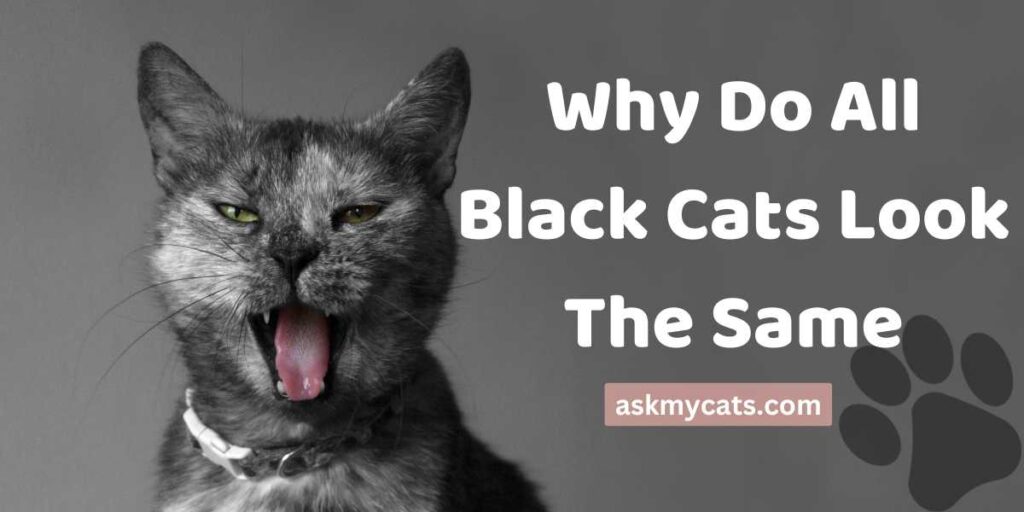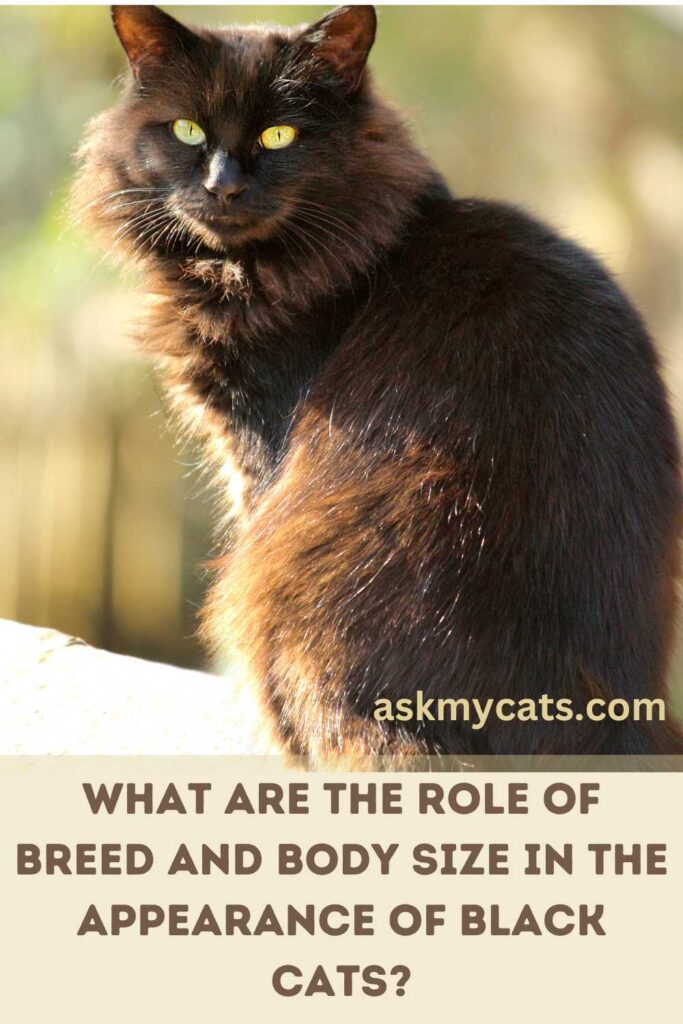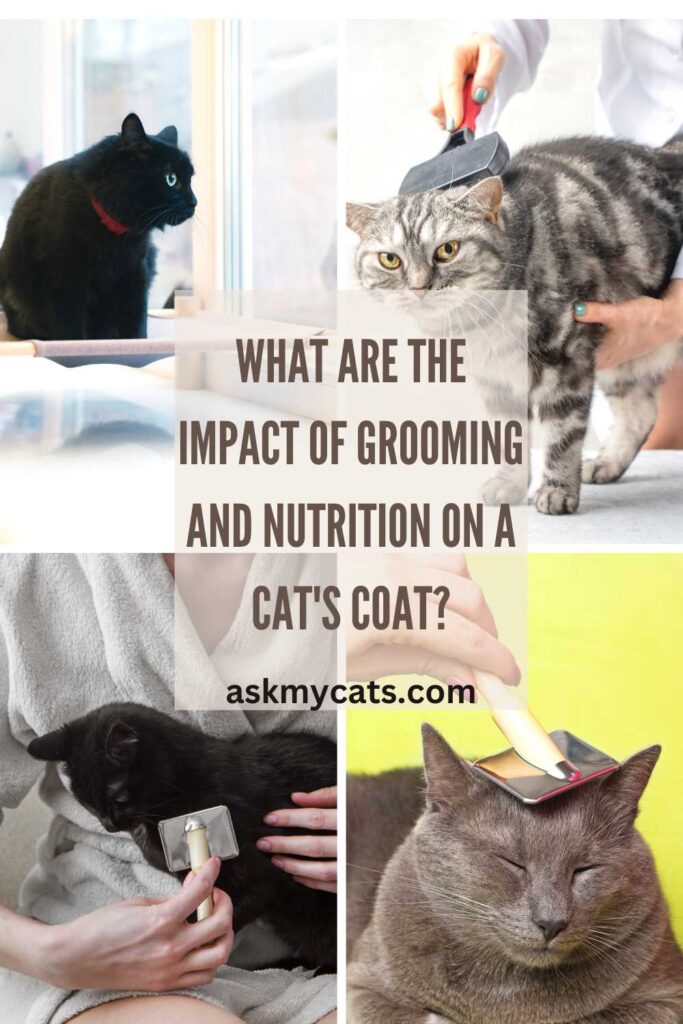Hey, there feline lovers!!
We all know about the myths and typecasts about black cats. I’m not only talking about the historic misunderstanding but even today we are jumbled about black felines. Don’t we?
One of those delusions is that all black cats look similar.
Let me break the glass castle! All black cats are individual like other colored cats. Acute observation makes it clear that all black has dissimilar and distinctive facial and body features.
Are you in the major mass who thinks all black cats look similar? Then this article is for you, I’m here to simplify all your doubts about black cats’ appearance.
Let’s dive together into the puzzling world of black felines!!
Key Takeaways
- The melanocortin 1 receptor (MC1R) gene determines the color of black cats’ fur and eyes.
- Cats have two types of melanin: phaeomelanin and eumelanin.
- The allele for black hair in cats is the non-agouti allele, which causes the cat to produce only eumelanin and have black fur.
- Male cats get their color transferred from the female parent, while female kittens can have fur color determined by either parent.
- The presence of the pigment melanin in black fur determines the color of the black cat’s coat.
- Melanin is not only responsible for pigmentation in black cats but also helps black cats to resist different diseases and allergies.


Give Your Cat the Perfect Day
Get the Free Ebook!
What Is The Science Behind Black Fur In Cats?

You must have seen the beautiful different shades in black cats which make them appear classy and splendid. But have you ever thought that why they have different shades and patterns?
If you’ll know the logic and science behind the color of black cats, then you will definitely appreciate their exclusive gorgeousness a little more and oust some of the mythologies nearby them.
The most important factor in black cats’ color is the melanocortin 1 receptor (MC1R) gene- the gene of black color in felines.
Additionally, this gene not only decides the fur color even the color of the eyes of cats is also influenced by it.
Cats have two types of melanin – phaeomelanin, which is responsible for producing black or brown color, and eumelanin, which produces brown or black color.
MC1R gene has different alleles which directly affect the color of your black cat.
The allele for black hair is recognized as the non-agouti allele, which causes the feline to make only eumelanin.
This outcome in black fur, irrespective of the kitten’s other hereditary factors
Though, Definitely, it’s not the only gene that determines the color of a cat’s coat.
Also, check out are black cats hypoallergenic
What Are The Genetics Of Coat Color In Cats?
We see cats daily, and they have different colors and shades, making them more adorable and attractive.
But did you ever imagine why cats have different colors? How few cats are in one color, and few are in bi-color or multi-color? Is it just that – they get those colors from their parents? But there are kittens who look different than their parents.
So, yes cats do get their color from their parents, but it is directly linked with the sex of the cats.
Male cats get their color transferred from the female parent. If the mother cat has a darker shade, then the male kitten will be darker in color. All male kittens mostly look like their mother on the basis of color.
Female kittens, on the other side, can have fur color resolute by either parent. This is because females get a gene for coat color from each parent. Female kittens generally will display either a dilute form of the parents’ colors or a blend of both parents’ colors.
Some fur colors must be connected to genetic factors carried by both parents to express in a kitten. For a female kitten to be cream or red, the male parent must be cream or red, and the female parent must have some form of cream or red in her fur.
the X-linked orange gene has two allelic forms. The OO allele produces orange fur, while the OB alleles produce non-orange (often black) fur.
Note, however, that because of X-chromosome inactivation, the result is mosaicism in expression. In OO / OB female heterozygotes patches of black and orange are seen, which produces the tortoiseshell pattern.
This is a rare example of co-dominance since the phenotype of both alleles can be seen. Note that the cat in part A has short fur compared to the cat in part B; recessive alleles at an independent locus (L/l) produce long (ll) rather than short (L_) fur.
Libretext Biology.
You might also like to know about Black Cat Spiritual Meaning
The Presence Of The Pigment Melanin In Black Fur
As we discussed black cats possess melanin in their genes and that is the reason, they are black.
Just like humans even in cats, melanin is the primary factor that affects the color of the black feline’s coat.
Melanin is in the hair sluices and receipts in the form of tiny granules, which vary in size, and arrangement. This can be one of the causes, there is a variety of colors in black felines’ coats. Recessive Genetic factors in Feline fur Genes can be recessive or dominant.
Melanin is not only responsible for pigmentation in black cats but even it helps black cats to resist different diseases and allergies.
Melanism is a recessive biological function present in a number of animals and birds, in which the dark-colored pigment melanin is developed in the skin and fur, giving the animal a dark or black-colored appearance. In this article, we will discuss the causes and effects of melanism in animals.
Animal shake
Interesting Read: Do Black Cats Live Longer?
What Are The Role Of Genetics In The Appearance Of Black Cats?
Genetics is the reason for the black color in black cats. Genes mutation carries forward the appearance in terms of body structures and pigments as well.
The mutations seem to have occurred independently over the duration and are fairly typical in the feline species they influence. Interestingly, they are not all same. For example, the gene that causes jaguars black is distinct from the one that provides tamed kittens black coats.
Not only the fur color but even genes are responsible for deciding the color of eyes in felines. You must have noticed that black felines have different shades of eyes, sometimes different from both parents – i.e., they got the dominating gene for a different color of eyes.
You would also like to read about Eye Color Of Black Cats
Just like other felines black cats also got their body size and structure from their parents in gene transformation. It decides if the cat will be heavy and bulky or small and light weighed.
In a nutshell, we can say that we see different shades in black say ivory black, jet black, tabby, brownish, cinnamon – all these varieties of shades are magic of genes crossing or passing.
The glorious silky Bombay cats are an example of the enchantment of genes in the appearance of feline.
Interesting Read: Are Black Cats Really Rare?
What Are The Role Of Breed And Body Size In The Appearance Of Black Cats?

There are 22 universally recognized breeds of black cats, and they look more or less different from each other.
If you will observe black cats of different breeds closely you might notice differences in color, a pattern of spots, body size, and even on facial structure.
For example, if you’ll see American short hair and British short you can easily say that the bulky one is British short hair – you don’t need any DNA check in this case as the difference is clearly visible.
And these differences are not accidental, but it is the effect of different breeds.
Interesting Read: Are Black Cats Friendly?
What Are The Impact Of Grooming And Nutrition On A Cat’s Coat?

Do you know one can easily detect your black cat’s health by observing her hair texture and condition?
A nourished coat should be lustrous and soft, not rough or flaky, and healthy fur should be lithe and clean, not greased, brittle, or uneven.
While nutrition impacts the polish and surface of your cat’s fur from the innards, routine grooming, and skin maintenance on the upper layer of skin and fur will also enable you to maintain your cat’s fur clear and free of messes.
All felines advantage from consistent brushing to eliminate loose hairs and lifeless skin cells, to preserve the fur free of dust, wreckage, and external parasites, and to allocate natural skin oils along the hair shafts.
Skin is the largest organ of your cat’s body. A less appropriate diet will not only harm your cat’s inner health, but it will also equally affect her outer appearance.
If you want your black feline to shine like her eyes, then a nutritious diet is the primary requirement.
Grooming and nutrition help your cat to Have shiny and healthy hair without any unnatural shady appearance.
Interesting Read: Black Cats And Halloween: History, Facts & Myths
What Is the Influence Of Lighting On The Appearance Of A Black Cat?
All black cats are not actually black though they seem like they are black in color – sounds dumb right?
Because of the presence of different gene combinations cats’ color coat is a confusing topic but if one gene is dominating and the other is recessive then there are chances that the cat will be tabby in appearance. Wanna check your cat on basis of a recessive and dominant gene?
Take her to the sunlight and you will notice a slight change in your cat’s hair color it is because of the natural lighting that is affecting the appearance of your black cat.
Even the darkest of black felines can appear changed in the sun. This can be partially due to cat genetic factors.
The lighting highly affects the appearance of black cats.
It’s possible that the cat you’re seeing in the sunlight is not black, to begin with. Although the rarest color of a cat is fawn, a dilution of cinnamon most commonly found in Abyssinians, you may be seeing a yellowish-brown color This can be partially due to the cat’s DNA segment.
Cats’ bodies, like humans, are made up of hereditary materials, named genes. Genes and their related alleles result in the color of cats’ eyes, the color of their hair, and other hereditary physical traits from their forebears, such as black fur.
Black color is nothing but a color that absorbs all other color and doesn’t reflect it back but if you take your cat to sunlight, you might notice that he has cinnamon or brown or burnt orange color. Because they cannot absorb those colors that means that is their real color.
Interesting Read: Are Black Cats Bad Luck?
Several Other Factors That Influence The Appearance Of Black Cats
You must have noticed kitties who are seemingly supposed to be black, but rather their coat is a rusty-brown color.
Possibly you’ve witnessed felines with shady fur on their back and sides even on their tails, paws, and faces. Or perhaps you’ve noticed one of your own cats’ switches colors slowly over the years.
Here are a few factors that can influence black cats’ appearance –
| Factors | Explanation |
|---|---|
| Temperature | Temperature plays a vital role in the color of black cats. In cats like Himalayan, Siamese, and other oriental cats. The pigment of black depends on the temperature of the surrounding. Mostly cats get darker in cold temp. |
| Sunlight’s effect | If you own a dark-colored feline, especially a black cat then you know how sunlight can lighten her fur color. If a black cat stays more in sun, then there is a high chance that it can affect your cat’s color appearance. |
| Age | As age grows most cats’ hair starts greying or lightening with time. It happens with all cats but in the case of black cats, it becomes more visible. |
Interesting Read: What Does It Mean When A Black Cat Comes To Your House?
Frequently Asked Question
How Can I Say What Breed My Black Cat Is?
There are several physical characteristics and traits of your cat’s breed, but you have to look at their shape and size, coloring, ears, fur type—and probably tail and face—to understand it.
Eyes are another option to detect the breed but mostly it’s a confusing option.
Is A Black Cat A Type Of Breed?
No, the black cat is not any breed, but it is a fur color that can be found in different breeds.
A black cat is a common cat with black fur (which can be of various shades and patterns). It can be an original breed or cross-breeding in different feline breeds and that will decide their shade and pattern of the color coat. The Cat Fanciers’ Association (CFA) identifies 22 cat breeds that can come with solid black coats. The Bombay breed is fully black.
Interesting Read: What Does It Mean When You See A Black Cat?
Final Words
It might be possible that your black kitty may look similar to your Neighbour’s black tom, at a glance.
Now you know that all black felines are individual, and they aren’t – look alike, all you need is a proper observation on basis of their fur, body size, facial structure, and eye color.
If you notice any quality or color difference in your cat’s coat from the original shade, then it can be an alarm for you that your kitty needs a proper diet according to her age and routine grooming too.
How do you differentiate between different breeds of black felines? Which breed do you find looks exactly similar in black cats? Tell us in the comment section.
Must Check Out: National Black Cat Day: When And How To Celebrate?
You would also like to read what it means when black cat crossing your path while driving
Interesting Read: What Does It Mean When A Black Cat Stares At You?
Must Read – Are Black Cats More Aggressive? Myth – Explained With Scientific Logic
